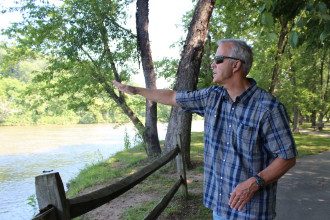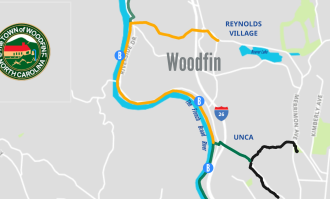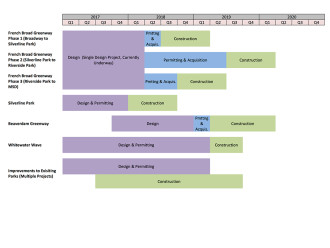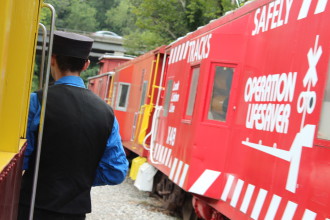At a time when rising construction costs are seriously threatening the prospects for several proposed local greenways, the Woodfin Greenway & Blueway is riding a wave of broad-based support and fundraising success.
The ambitious undertaking will comprise 5 miles of greenway, a brand-new park plus the area’s first constructed whitewater play wave. And with $11.6 million in funding commitments in hand toward a generously estimated $13.9 million budget, there seems to be a boatload of momentum.
But what is it that’s propelling this project forward when the future of the Beaucatcher, Town Forest, Bacoate Branch and French Broad River West greenways seems in doubt?
Prime mover

One key factor in the Woodfin project’s early success has been the involvement of former Asheville Vice Mayor Marc Hunt, who chaired the city’s Greenway Commission for several years before winning elected office. Though he’s quick to deflect attention from himself and tout the wide range of supporters who’ve signed on to Woodfin’s plans, Hunt concedes that he’s put in at least 1,400 volunteer hours in the last year alone.
This isn’t Hunt’s first rodeo. Way back in the 1970s and early ’80s, he and other whitewater rafting enthusiasts built a coalition that eventually persuaded the Tennessee Valley Authority to schedule regular water releases on the Ocoee River. That spawned a wildly successful whitewater industry on the river, which was subsequently chosen as the site of the whitewater competitions for the 1996 Olympic Games.
And in 2015, Hunt was part of a group that pushed for creating a whitewater play wave in the River Arts District, though that idea didn’t gain traction. But the following year, says Hunt, the Woodfin Board of Aldermen took a look at incorporating a wave and expanded river access into a planned greenway project — and got excited about developing the town’s riverfront to spur economic growth.
Town and county
In July of last year, the board agreed to place a $4.5 million bond issue on the November ballot. The measure was approved by a wide margin, winning over 70 percent of the vote.

Town leaders, Hunt explains, “had looked around and seen that in communities with recreational amenities and better parks and river access, quality of life is up and businesses want to locate there.” He believes the town is ripe for investment, much as West Asheville was a couple of decades ago.
“With its reputation of being less hip, less walkable and bikeable,” says Hunt, “Woodfin hasn’t been seen as the place to move to. But that’s changing.” Debbie Giezentanner, the Woodfin alderwoman who originally proposed the bond resolution, told Xpress last year that adding the greenway would boost interest in residential and commercial development.
Woodfin’s upfront commitment to cover a significant chunk of the budget gave the project a leg up, notes Hunt. Other major funding commitments include $4 million from the U.S. Department of Transportation, $2.25 million from the Buncombe County Tourism Development Authority and over $900,000 from other public entities and private donors.
Landowners on board
Another big thing the project has going for it is the support of most of the handful of landowners along the greenway route. Beginning at the town line on Riverside Drive, for example, Silver-Line Plastics holds over a mile of riverfront property. The company, says Hunt, is “totally on board” with the project and has agreed in principle to let the greenway run along a dike that buffers the manufacturing facility from flooding.

In 2012, Silver-Line donated a 4.5-acre riverfront parcel north of its factory to Woodfin to create a new park. Earlier this year, the town bought an adjacent property, adding another acre and a building that will be repurposed to provide restrooms and space for complementary commercial uses, such as outfitters.
Silver-Line Park will include a boat ramp, parking, picnic areas, a restored natural wetland, a playground and walking trails. With construction scheduled for next year, the new park will be the first part of the greenway and blueway to be completed.
Other property owners along the route include the N.C. Department of Transportation, Waste Pro, the French Broad River Academy, the Metropolitan Sewerage District, Riverside Business Park and private development interests.
Down by the river
Downstream from the new park, the greenway will follow the French Broad to Woodfin River Park, a well-loved amenity that will get improvements to its walking paths, picnic areas, restrooms, parking and riverbanks.
This will also be the site of the project’s most innovative component: an artificial whitewater play wave that project planners say will draw boaters and spectators alike. In its successful application to the Tourism Development Authority, the project team wrote, “There are no significant rapids in the French Broad through Asheville and Woodfin, and the Woodfin wave will change that. The wave will be the most fun and exciting place to be on the French Broad.”
Engineer Scott Shipley, a whitewater kayaker who competed in three Olympic Games and holds four world titles, conducted the feasibility studies and created a conceptual design for the wave.
Now a Colorado resident, Shipley formerly lived and trained at the Nantahala Outdoor Center near Bryson City, so he knows a thing or two about Western North Carolina’s rivers. He’s designed a host of such whitewater features, including the London 2012 Olympic whitewater venue, Durango, Colo.’s Whitewater Park and the U.S. National Whitewater Center in Charlotte.
The Woodfin wave, Hunt explains, will be formed by a concrete structure spanning the entire width of the river that will concentrate the flow and produce an exciting but safe wave at various water levels. Scale models built as part of the design process will help optimize the wave’s shape and characteristics, making it suitable for both beginners and expert paddlers, he says.
Federal regulations, adds Hunt, require extensive modeling to ensure that any feature added within a designated flood hazard zone won’t increase the risk “by even one-tenth of an inch.”
Working on the railroad
From River Park, the greenway will continue through the Riverside Business Park and Metropolitan Sewerage District properties.
At the junction of Elk Mountain Road and Riverside Drive, the greenway will turn east, heading away from the French Broad to follow a 1.5-mile stretch of Beaverdam Creek to the center of Woodfin.
A mostly abandoned roadbed and the tracks of the Craggy Mountain Line wind through what Hunt calls “the gorge,” a ravine that was previously the site of an Asheville landfill and, later, a nine-hole golf course.
Surrounded by commercial and residential development, the creek’s thickly wooded banks have a surprisingly remote and pastoral quality. “You feel like you’re somewhere in Madison County when you’re down here,” Hunt remarks, and a man passing by on foot says he’s just seen a deer.

But while the Craggy Mountain Line may seem quiet on a weekday morning, there’s plenty going on with the excursion railway, says Rocky Hollifield, the nonprofit’s president. “We don’t advertise a lot, but we take about 3,000 people a year” on trips along the creek and the French Broad to the planned greenway’s starting point.
The group is working to preserve this section of track, which he says has been in continuous use since 1904. It’s the last remaining vestige of Asheville’s once extensive streetcar system, notes Hollifield. The hour-and-a-quarter trip currently runs on the second and fourth Saturdays of the month.
And though the greenway could be a boon to the venture, Hollifield says there are still some details to be worked out. For any railroad, he explains, maintaining a clear right of way on both sides of the track is essential for safe operation. And at some points along Beaverdam Creek, trying to accommodate a road, tracks and a greenway gets “pretty tight,” he says.
One exciting prospect for the Craggy Mountain Line is the possibility of establishing a station and a railroad history museum at the future Silver-Line Park. Hollifield says he has a substantial collection of railroad artifacts and memorabilia that he’d love to share with the public.
Getting there
Most folks know what a greenway is, notes Hunt, but a blueway is a less familiar concept. Where rivers are concerned, access is critical: The prospect of bushwhacking through vegetation along treacherous banks and trespassing on private property may deter even the most avid paddler.
French Broad Riverkeeper Hartwell Carson agrees that providing safe and legal access points is critical for reconnecting people to the area’s waterways. “The more people that come down and experience the French Broad, the more they’ll want to see it clean and put in time to work on it,” he points out.
The 140-mile French Broad River Paddle Trail, created by environmental nonprofits RiverLink and MountainTrue, has sparked increased interest in longer, multiday trips on the river. But paddlers need convenient access to get on and off the water and skirt hazards such as dams.
Traffic on the French Broad, notes Carson, has increased dramatically during the 12 years he’s worked as riverkeeper.
And Garrett Artz, RiverLink’s executive director, says that thanks to improved river access and cleanups, the French Broad is now drawing 50,000 visitors a year. “We’ve made a lot of strides — not just RiverLink, but as a community — and we have to make sure we don’t backslide. I think the river is still running browner than it should, and we want to make sure people are comfortable. If we continue to move forward, I think we’re going to be counting in the hundreds of thousands that move through town,” Artz told the N.C. News Service on July 24.
Heath White of Zen Tubing says his business has grown over 200 percent annually since it launched six years ago. In July alone, notes White, his company is putting over 4,000 people on the river every weekend.
Still, White feels the river’s potential for tourism is far from fully realized, and he says he welcomes more companies and more competition to make Asheville a tubing destination. Extending those opportunities into Woodfin, he maintains, will help make it happen.
Eric Bradford of Asheville GreenWorks believes the whitewater wave and other features will increase both river traffic and the number of spectators along the banks. “This is going to blow up for Woodfin,” he predicts.
Connecting the dots
But maximizing the value of greenways — for recreation, transportation, economic development and environmental benefit — requires longer, more connected networks, says Hunt. And creating those connections will be one of the biggest challenges for the Woodfin Greenway & Blueway.
Linking the Woodfin project to greenways under construction in Asheville’s River Arts District is both crucial and tricky, Hunt explains. Plans for a 1.5-mile greenway that would run from the Norfolk Southern bridge over Riverside Drive to the Woodfin town line, for example, are in the very early stages. The route is technically challenging, with many buildings located close to the river and road and a lot of different property owners.
But despite those constraints, he maintains, now is the time to tackle the project, since the state Department of Transportation plans to widen that stretch of Riverside Drive in 2020. If the project doesn’t include or allow for a greenway, he argues, it will be even harder to create one later.
Hunt also hopes a connector along Broadway will eventually link the Woodfin route to the Reed Creek and Glenn’s Creek greenways near UNC Asheville and downtown.
Another risk for the Woodfin project is the huge discrepancies between the estimated costs and the actual project bids that have delayed construction for three River Arts District greenways and the Beaucatcher Greenway. To guard against that, says Hunt, the Woodfin project team added up to 30 percent to its conservative cost estimates. Those generous allowances, he notes, impressed the Tourism Development Authority committee that approved the funding for the project.
All this and more
If all goes according to plan, picnickers could conceivably be cracking open coolers and spreading red-checkered tablecloths in Silver-Line Park by the end of next year, though such warm weather activities might need to wait at least until the following spring. The schedule calls for construction of the whitewater wave and other park improvements to wrap up in 2019.
The Buncombe County Parks and Programming Division will manage the construction of all sections of the Woodfin Greenway, says Hunt. That work is scheduled to conclude in mid-2020.
But with the cost and complexity of constructing such systems already high and rising fast, he concedes, “Some people ask, ‘Why do we need greenways?’”
For Hunt, though, there isn’t one single answer — and that’s the key to the unique appeal and benefits of these devilishly difficult infrastructure projects, which often fall apart along the winding path from bright idea to completed amenity.
“Some people, their experience and goal is about recreation and aesthetics: a linear park, wooded, with trees, a place to get away, get some exercise, do their walking or jogging or riding a bike,” he explains. “Others are like, ‘This is all about transportation. This is about getting from my house to where I work.’”
And it’s precisely because “it can be all of that,” says Hunt, that he believes the Woodfin Greenway & Blueway can succeed where other local projects have stalled. There’s something for everyone, from weekend bicycle warriors to commuters, and from Woodfin landowners to entrepreneurs seeking a piece of the tourism pie.
It’s personal
For Hunt, though, expanding access to the French Broad River is as much personal as it is political. Shortly after the former vice mayor lost a City Council re-election bid in November 2015, Taylor Hunt, the younger of his two sons, was killed in a kayaking accident in Ecuador. Along with friends and other community members, Hunt, his wife, Cat Potts, and their son Colin Hunt established the Taylor Hunt Fund for Rivers and Outdoor Learning to promote whitewater preservation and recreation.
Last November, the French Broad River Academy dedicated a new boat ramp on the French Broad in Taylor’s memory. Grants from the Taylor Hunt Fund have benefited the river protection organization American Whitewater, the environmental learning program Muddy Sneakers and the scholarship fund at Camp Mondamin in Zirconia, where Taylor was a paddling instructor.
“Taylor’s life and our loss of him are indeed a source of inspiration and energy for me in this project,” Hunt says. “Taylor loved rivers and paddling and teaching outdoor skills to youth. And he was all about community. I think Taylor would be very happy with the way this project will connect people to the river and the natural world.”
Fueled by Hunt’s passion, plans for the Woodfin Greenway & Blueway have advanced further in one year than those other proposed local projects have in several. It remains to be seen whether that momentum is enough to carry Woodfin’s dreams into a bright new future, but supporters have ample reason for optimism.






Thank you, Virginia and Brent for honoring the project with your great writing and art. Big shout-out as well to many others who are driving this project including Mayor Jerry VeHaun and all the leaders of the Town of Woodfin, to Brownie Newman, Josh O’Conner and the leadership at Buncombe County, to Rick Lutovsky and and others who work so hard on the fundraising front, and to all project partners and supporters.
While progress is great for the project, it needs lots of community support to become a reality – and donations to fill the funding gap are critical.
Learn more at woodfingreenwayandblueway.org
Marc, thank you for working with the necessary people/entities to move this much needed project forward. My family and I live near there and it would be wonderful to have that land be better used. We would like to donate, but the link on your site for the “overall” donation doesn’t seem to work. The link for the wave specific donation does. As cool as it will be to see the wave everyday, we are much more interested in giving to the overall project, as we would use the greenway sections far more regularly. Thanks again, and we will be checking the site to see if the link is fixed.
Matt –
Thank you so much for your enthusiasm and for supporting the project! I believe we have the donate button fixed now; so sorry for the inconvenience. Please email me at marc.hunt@woodfingreenwayandblueway.org if there are any further snags.
~Marc
Chapeau to everyone involved in planning this much-needed greenway/blueway. Hopefully the City of Asheville is paying attention! I think we let the City off the hook by explaining away its repeated failures as being grounded in rising construction costs. Too many projects have failed to materialize and I argue that we need to look deeper. Successful projects require not just sound planning, but dedicated champions in city hall. Take a look at greenway-rich cities across the country and you’ll see that a big component of their success comes from within city hall. Talented staff who have been given a mission and can carry it out. It’s one thing to adopt comprehensive greenway and bicycle/walking plans, but without champions in city government they’ve come to highlight a remarkably poor track record of unmet goals, promised projects that are delayed indefinitely, and no clear path toward narrowing the chasm between the talk and the walk.
No thank you! The poopy river that the MSD ignores isn’t a good place to put a recreational activity. Do you want to be sued for making people sick?! So much money for tourism while locals beg for existing infrastructure improvements. Gross.
The water quality in the French Broad has improved greatly over the past 30+ years, and a key motivation for this project is continuing with that. Connecting people and our community to the river through recreation will cause us to be better stewards.
Based on testing, there are certain days – usually after heavy rains when sediments are stirred up – where river users should be cautious. Most days are safe. Tens of thousands of people now float the river in Buncombe and Madison Counties every year. Let’s make it safer and cleaner.
The TDA is a very supportive funder in this project, and their board’s concern and interest in improved water quality is one reason they are supportive.
And note that the location of the Wave project is upstream of the MSD plant….